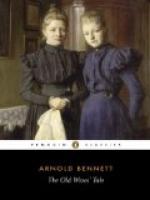And the mess! It seemed inconceivable that the material mess could ever be straightened away!
Yet, ere the fields of the county were first covered with snow that season, only one sign survived of the devastating revolution, and that was a loose sheet of wall-paper that had been too soon pasted on to new plaster and would not stick. Maria Insull was Maria Critchlow. Constance had been out into the Square and seen the altered sign, and seen Mrs. Critchlow’s taste in window-curtains, and seen—most impressive sight of all—that the grimy window of the abandoned room at the top of the abandoned staircase next to the bedroom of her girlhood, had been cleaned and a table put in front of it. She knew that the chamber, which she herself had never entered, was to be employed as a storeroom, but the visible proof of its conversion so strangely affected her that she had not felt able to go boldly into the shop, as she had meant to do, and make a few purchases in the way of friendliness. “I’m a silly woman!” she muttered. Later, she did venture, timidly abrupt, into the shop, and was received with fitting state by Mrs. Critchlow (as desiccated as ever), who insisted on allowing her the special trade discount. And she carried her little friendly purchases round to her own door in King Street. Trivial, trivial event! Constance, not knowing whether to laugh or cry, did both. She accused herself of developing a hysterical faculty in tears, and strove sagely against it.
CHAPTER VIII
THE PROUDEST MOTHER
I
In the year 1893 there was a new and strange man living at No. 4, St. Luke’s Square. Many people remarked on the phenomenon. Very few of his like had ever been seen in Bursley before. One of the striking things about him was the complex way in which he secured himself by means of glittering chains. A chain stretched across his waistcoat, passing through a special button-hole, without a button, in the middle. To this cable were firmly linked a watch at one end and a pencil-case at the other; the chain also served as a protection against a thief who might attempt to snatch the fancy waistcoat entire. Then there were longer chains, beneath the waistcoat, partly designed, no doubt, to deflect bullets, but serving mainly to enable the owner to haul up penknives, cigarette-cases, match-boxes, and key-rings from the profundities of hip-pockets. An essential portion of the man’s braces, visible sometimes when he played at tennis, consisted of chain, and the upper and nether halves of his cuff-links were connected by chains. Occasionally he was to be seen chained to a dog.




